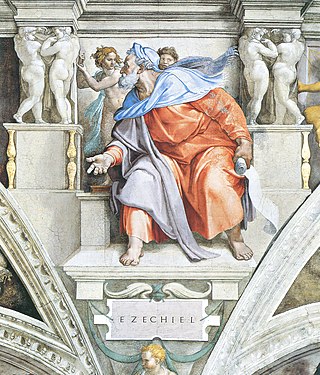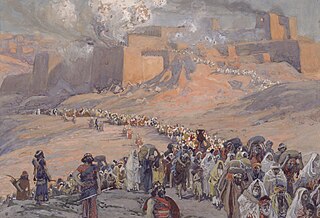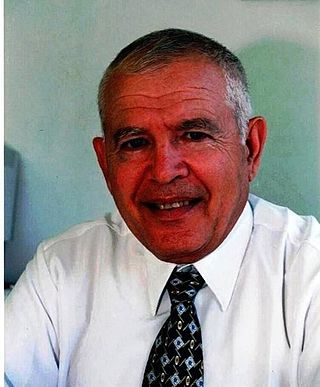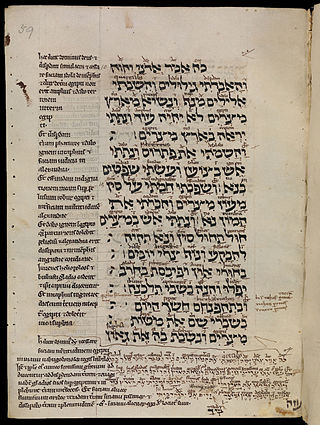Related Research Articles

Ezekiel, also spelled Ezechiel, was an Israelite priest. The Book of Ezekiel, relating his visions and acts, is named after him.

The Euphrates is the longest and one of the most historically important rivers of Western Asia. Together with the Tigris, it is one of the two defining rivers of Mesopotamia. Originating in Turkey, the Euphrates flows through Syria and Iraq to join the Tigris in the Shatt al-Arab in Iraq, which empties into the Persian Gulf.

The Babylonian captivity or Babylonian exile was the period in Jewish history during which a large number of Judeans from the ancient Kingdom of Judah were forcibly relocated to Babylonia by the Neo-Babylonian Empire. The deportations occurred in multiple waves: After the siege of Jerusalem in 597 BCE, around 7,000 individuals were deported to Mesopotamia. Further deportations followed the destruction of Jerusalem and Solomon's Temple in 587 BCE.
Aviv means "spring (season)" in Hebrew. Aviv is the first month of the year in the Pentateuch, and is later called Nisan in the book of Esther and in subsequent post-exilic history up to the present day. These names are sometimes used interchangeably, although Aviv refers to the three-month season, and Nisan is called the "first month of Aviv." Aviv is also used as a given name, surname, and place name, as in Tel Aviv.

A cherub are one of the unearthly beings in Abrahamic religions. The numerous depictions of cherubim assign to them many different roles, such as protecting the entrance of the Garden of Eden.

The Khabur River is the largest perennial tributary to the Euphrates in Syria. Although the Khabur originates in Turkey, the karstic springs around Ras al-Ayn are the river's main source of water. Several important wadis join the Khabur north of Al-Hasakah, together creating what is known as the Khabur Triangle, or Upper Khabur area. From north to south, annual rainfall in the Khabur basin decreases from over 400 mm to less than 200 mm. This has made the river a vital water source for agriculture throughout history. The Khabur joins the Euphrates near the town of Busayrah.

The Nephilim are mysterious beings or people in the Bible traditionally imagined as being of great size and strength, or alternatively beings of great power and authority. The origins of the Nephilim are disputed. Some, including the author of the Book of Enoch, view them as the offspring of rebellious angels and humans. Others view them as descendants of Seth and Cain.
Rehoboth is the name of three biblical places.

The mina is an ancient Near Eastern unit of weight for silver or gold, equivalent to approximately 1.25 pounds (0.57 kg), which was divided into 60 shekels. The mina, like the shekel, eventually also became a unit of currency.

The Spaceships of Ezekiel (1974) is a book by German engineer Josef F. Blumrich about a spaceship that was supposedly observed by the prophet Ezekiel as described in Book of Ezekiel in the Tanakh. Blumrich wrote it while chief of NASA's systems layout branch of the program development office at the Marshall Space Flight Center. It was originally published in German by Econ Verlag GmbH under the title Da tat sich der Himmel auf. Because it refers to theories and speculations about ancient astronauts, it is considered to be a work of pseudoscience as well as being an example of euhemerism.

The Shatt en-Nil Is a dry river bed/canal in southern Iraq. It is also known as the Naru Kabari.
Daniel Isaac Block is a Canadian/American Old Testament scholar. He is Gunther H. Knoedler Professor Emeritus of Old Testament at Wheaton College.

The Al-Yahudu tablets are a collection of about 200 clay tablets from the sixth and fifth centuries BCE on the exiled Judean community in Babylonia following the destruction of the First Temple. They contain information on the physical condition of the exiles from Judah and their financial condition in Babylon. The tablets are named after the central settlement mentioned in the documents, āl Yahudu, which was "presumably in the vicinity of Borsippa".

Moshe Garsiel is professor emeritus of Bible at Bar-Ilan University.

Ezekiel 1 is the first chapter of the Book of Ezekiel in the Hebrew Bible or the Old Testament of the Christian Bible. This book contains prophecies attributed to the prophet/priest Ezekiel, and is one of the Books of the Prophets. In the New King James Version, this chapter is sub-titled "Ezekiel’s Vision of God", and in the New International Version, "Ezekiel’s Inaugural Vision". In the text, the first verse refers to "visions" (plural).

Ezekiel 3 is the third chapter of the Book of Ezekiel in the Hebrew Bible or the Old Testament of the Christian Bible. This book contains the prophecies attributed to the prophet/priest Ezekiel, and is one of the Books of the Prophets. This chapter contains the call to Ezekiel to speak to the people of Israel and to act as a sentry for them.

Ezekiel 10 is the tenth chapter of the Book of Ezekiel in the Hebrew Bible or the Old Testament of the Christian Bible. This book contains the prophecies attributed to the prophet/priest Ezekiel, and is one of the Books of the Prophets. In this chapter, Ezekiel sees "God's Glory depart from the Temple".

Ezekiel 43 is the forty-third chapter of the Book of Ezekiel in the Hebrew Bible or the Old Testament of the Christian Bible. This book contains the prophecies attributed to the prophet/priest Ezekiel, and is one of the Books of the Prophets. Chapters 40-48 give the ideal picture of a new temple. This chapter contains Ezekiel's vision of the glory of God returning into the temple, Ezekiel 43:1-6; God promises to dwell there, if the people will put away their sins, Ezekiel 43:7-9; to incite them to repentance, the prophet shows them the model and law of the house, Ezekiel 43:10-12; the measures of the altar, Ezekiel 43:13-17; the ordinances thereof, Ezekiel 43:18-27.
References
- ↑ Ezekiel 1:1, Ezekiel 1:3, Ezekiel 3:15, Ezekiel 3:15, Ezekiel 3:23, Ezekiel 10:15, Ezekiel 10:20, Ezekiel 10:22, and Ezekiel 43:3. Reference
- ↑ Thompson, Henry O. (1992). "Chebar," in Anchor Bible Dictionary . Vol. 1. Doubleday. p. 893. ISBN 0-385-19351-3.
- ↑ Allen, Leslie C. (1994). Word Bible Commentary: Ezekiel 1–19. Dallas: Word, Incorporated. p. 22. ISBN 0-8499-0830-2.
- ↑ Block, Daniel I. (1997). NICOT: The Book of Ezekiel: Chapters 1–24. Grand Rapids, Michigan: Eerdmans. p. 84. ISBN 0802825354.